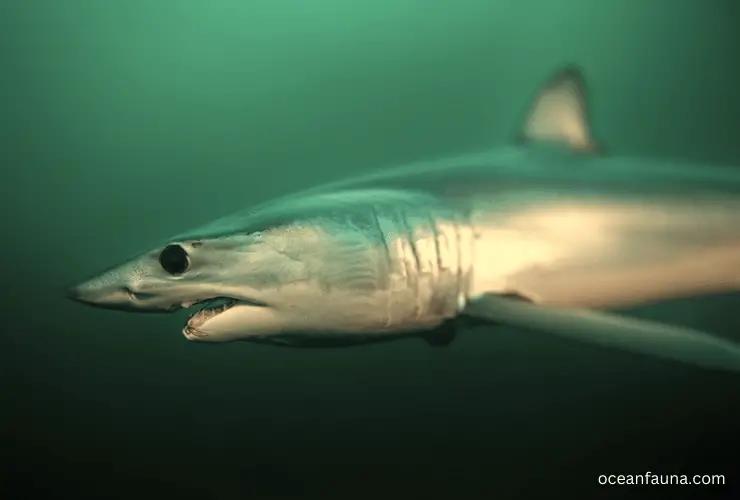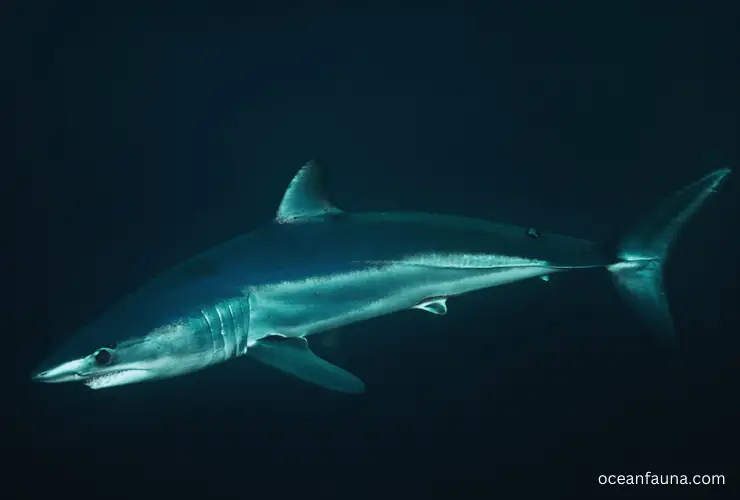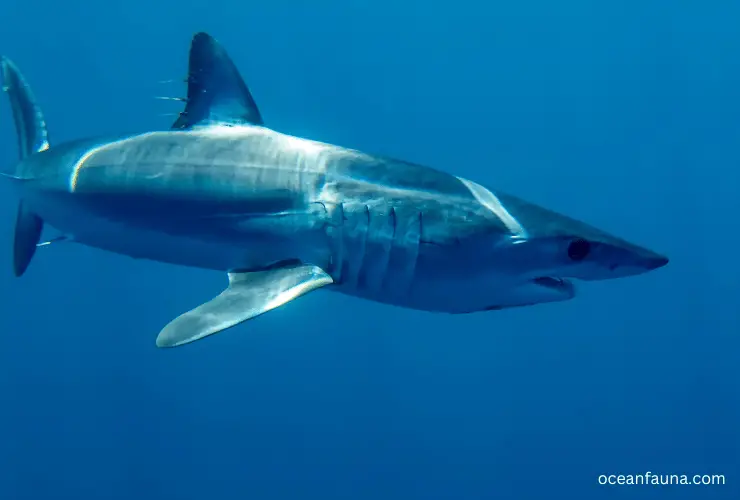Longfin mako sharks are a Mackerel shark species that are found in the waters of the western Atlantic, the eastern Pacific, and the Mediterranean Sea. Well, two types of mako sharks are there. One is the longfin mako, and the other is the shortfin mako (the fastest shark species).
The longfin shark earned its name from the remarkably lengthy pectoral fins that can stretch beyond its head. Apart from that, so many interesting fun facts are there about longfin sharks, and in this article, I will discuss all of them in detail.
Longfin Mako Shark at a Glance
| Category | Information |
| Common names | Longfin Mako |
| Scientific name | Isurus paucus |
| Order | Lamniformes |
| Family | Lamnidae |
| Diet | Schooling fish, squid, tuna, other bony fish |
| Habitat | Open ocean, pelagic waters |
| Distribution | Mainly Western Atlantic and probably Central Pacific |
| Size | Up to 4.3 meters (14 feet) in length |
| Weight | Up to 500 kilograms (1,100 pounds) |
| Speed | 35 mph |
| Life expectancy | Estimated to be ranging betwwen 28-35 years in the wild |
| Reproduction | Aplacental Viviparous |
| Gestation period | 15-18 months |
| Litter size | 2-8 pups |
| Conservation status | Vulnerable |
The Longfin Mako Shark (Isurus paucus) is a highly elusive and rare species of shark that is found in deep and tropical waters around the world. This shark is considered a member of the Mackerel Shark family and is one of the largest species in the group, capable of achieving lengths of up to 14 feet (4.3 m) and weights exceeding 500 kg (1100 lbs).
One of the most distinctive features of the Longfin Mako Shark is its long, slender fins, which give it a highly aerodynamic shape and stunning look. Unlike many other sharks, this species has a highly developed sense of vision which it uses to actively hunt its prey.
The Longfin Mako Shark is renowned for its predatory ferocity, hunting with voracity on bony fish like mackerel, swordfish, pelagic squid, bonito, and tuna. Even when scavenging in schools of other feeding fish, it still manages to dominate the waters around it.
Fun Facts: Longfin Mako Sharks
- Longfin Mako Sharks get their name for having two lengthy pectoral fins.
- In size, females can grow up to 4.3 meters, and males reach up to around 3.5 meters.
- The maximum speed of a longing shark is 35 mph.
- The lifespan of longfin mako sharks is estimated to be up to 35 years old.
- Longfin mako sharks are not aggressive like shortfin mako sharks.
- Regarding reproduction, longfin mako sharks are aplacental viviparous, meaning that their young develop in the uterus from a yolk sac and are born alive.
- The conservation status of longfin mako sharks is vulnerable.
Anatomy of Longfin Mako Shark
Longfin Mako Sharks are a fascinating species of shark with unique anatomical features that allow them to thrive in their deep-sea habitat. Let’s take a closer look at the various anatomical systems of the Longfin Mako Shark.
Appearance

The Longfin Mako Shark has a sleek and streamlined appearance which allows it to swim quickly and efficiently through the water. It has a large, tapered body with wide-set eyes, an elongated snout, and long, slender pectoral fins that stretch beyond its head.
Skeletal System
The skeletal system of Longfin Mako Sharks is made up of cartilage, which is flexible but strong. Their jaws are made up of several rows of sharp, triangular teeth that are constantly being replaced. They also have a highly developed sense of smell, thanks to the numerous olfactory sacs that are located in their skull.
Muscular System
The muscular system of the Longfin Mako Shark is highly developed, enabling it to move quickly and efficiently through the water. It has two large pectoral fins, which it uses for propulsion and two large caudal fins that provide stability so it can swim swiftly through the water.
Respiratory System
The respiratory system of the Longfin Mako Shark consists of five to seven pairs of gills that extract oxygen from the water. Their gills are highly efficient at extracting oxygen, which allows them to remain active in deep waters for extended periods.
Nervous System
The Longfin Mako Shark’s nervous system is highly developed, allowing it to process sensory information quickly and react accordingly. They have a keen sense of smell, vision, and hearing, which helps them to locate their prey even in low light conditions.
Digestive System
The digestive system of the Longfin Mako Shark is highly efficient. They have several rows of teeth that enable them to rip off chunks of flesh from their prey. Their digestive system is capable of breaking down their prey’s bone, skin, and flesh into small, absorbable pieces.
Circulatory system
Like other sharks, longfin mako sharks also have a two-chambered heart and a closed circulatory system, and the blood is pumped from the heart to the gills for oxygenation and then back into the body. The longfin mako shark has an extraordinary amount of hemoglobin in its blood which helps it to transport more oxygen than other species of sharks.
How Big Is a Longfin Mako Shark?
The longfin mako shark is a formidable predator that can grow to be quite large. The maximum longfin mako shark size is up to 14 feet (4.3 m). However, their size can vary depending on several factors, including their gender, age, location, and feeding habits.
These sharks are also quite heavy, sometimes weighing as much as 1,100 pounds (500 Kg). It’s worth noting that females tend to grow larger than males, although the difference is not particularly significant.
Longfin Mako sharks are a relatively slow-growing species of shark, and their growth rate, along with their lifespan, is influenced by their gender. Female sharks typically grow larger and live longer than their male counterparts.
On average, females can grow up to 4.3 meters in length and weigh around 500 kilograms, while males reach a maximum length of 3.5 meters and weigh around 400 kilograms.
Young sharks can grow up to a meter in their inaugural year, while mature males reach an average length of 2 meters and females around 2.5 meters. After maturity is reached, these creatures will continue to expand at a slower rate until they have attained maximum size.
What Do Longfin Mako Sharks Eat?
Longfin mako sharks, Isurus paucus, are known to feed on a variety of prey, including bony fishes, pelagic squids, and schooling fishes. These sharks are apex predators and are well-equipped to hunt for their prey.
Although the longfin mako shark diet is not as well-known as that of the shortfin mako, research suggests that these sharks have a similar diet.
In terms of nutritional needs, the longfin mako shark requires a high-protein diet to support its muscle mass, as well as a source of fats and oils for energy.
Makos are active predators and require a lot of energy to hunt and swim. The prey they consume is a rich source of essential amino acids, as well as other important nutrients like minerals and vitamins.
Longfin mako sharks are known for their speed and agility in the water. They can swim at high speeds for extended periods, which allows them to catch fast-moving prey like tuna, squids, and schooling fish.
Their hunting style involves a combination of stealth and speed. Once they have located their prey, they will rapidly approach and strike with their powerful jaws, using serrated teeth to tear flesh and crush bones.
In addition to their impressive hunting skills, longfin mako sharks are also able to detect prey using their keen senses. They have an excellent sense of smell and can detect the scent of prey from long distances away. They are also able to detect changes in water pressure and can use this ability to locate schools of fish or other prey items.
Where Do Longfin Mako Sharks Live?
Longfin mako sharks are known to inhabit the western Atlantic, particularly in Gulf Stream waters, northern Cuba to south-eastern Florida. They have also been reported in the central Pacific near Phoenix Island and north of Hawaii. These pelagic species are typically found in moderately deep water and have been observed at depths of up to 220 meters (720 feet).

During the day, longfin makos primarily reside in the upper mesopelagic zone, which is the layer of ocean water between 200 and 1000 meters (656 and 3281 feet) deep. However, at night they venture into the epipelagic zone, which is the top layer of the ocean extending from the surface down to a depth of around 200 meters (656 feet).
Longfin mako sharks have a vast distribution but are relatively common in the western Atlantic. They tend to inhabit warm waters in subtropical and tropical regions. Along with their deep-water habitat preference, they are also able to tolerate a slightly wider range of temperatures than other shark species.
How Fast Is a Longfin Mako Shark?
The longfin mako shark can reach speeds of up to 35 mph or 56 kph. This makes it one of the fastest sharks in the ocean, but it is not quite as fast as its counterpart, the shortfin mako shark, which can reach top speeds of 45 mph or 70 kph.
However, the longfin mako’s speed is one of its greatest assets when it comes to hunting prey and evading predators. This shark’s streamlined body and powerful, crescent-shaped tail allow it to move through the water with incredible efficiency, making it a force to be reckoned with in the open ocean.
While the longfin mako may not be quite as fast as the shortfin, it is still an impressive swimmer by any measure and one of the most formidable predators in the sea.
What Is the Lifespan of Longfin Mako Sharks?
Longfin Mako sharks are known to have a lifespan of 28 to 35 years on average. This species of shark belongs to the family of Lamnidae and is widely distributed across many parts of the world, particularly in tropical and warm temperate waters.
Their lifespan can vary depending on several factors, such as their environment, diet, and genetics. For instance, a healthy longfin mako shark that feeds on a varied diet of fish, squid, and other marine animals, and lives in suitable water conditions, will likely have a longer lifespan compared to those that live in polluted waters or have limited food sources.
Longfin Mako sharks are susceptible to a range of natural and human-induced threats that can impact their lifespan. Some of their natural predators include larger sharks and killer whales, while human activities such as overfishing, bycatch, and habitat destruction can also have a significant impact on their populations.
How Do Longfin Mako Sharks Reproduce?
Longfin Mako sharks reproduce through aplacental viviparity, which means that the embryos develop inside the uterus of the female shark without a placenta. Instead of receiving nutrients and oxygen through a placenta like mammals do, Longfin Mako shark embryos receive nourishment from yolk sacs.
As the unborn young continue to develop inside the uterus, they are fed unfertilized eggs by the mother, a process called oophagy.
The gestation period of Longfin Mako sharks lasts between 15 to 18 months. At the end of the gestation period, only 2-8 juvenile sharks are born, and each individual is around 28 inches (70 cm) in length. This is a very small number of offspring compared to other shark species.
Furthermore, Longfin Mako sharks have a low reproductive capacity, which makes them vulnerable to overfishing and other threats. Female Longfin Mako sharks only breed once every two to three years.
The low reproductive capacity and slow growth rate of Longfin Mako sharks make them highly susceptible to population decline, which has led to their classification as an endangered species.
Are Longfin Mako Sharks Aggressive to Humans?
Based on available evidence, longfin mako sharks are not considered aggressive toward humans. Unlike their shortfin mako shark counterparts, who are known to attack humans, there has never been a recorded incident of a longfin mako shark attacking a person.
However, all shark species are wild animals and should be treated with respect and caution when encountered in their natural habitats.
Also, like other sharks, longfin mako sharks may become defensive if threatened or provoked. Therefore, it is always advisable to exercise caution when swimming or diving in areas where sharks are known to inhabit and to follow recommended safety protocols to avoid any potential harm to both humans and sharks.
What Is the Conservation Status of Longfin Sharks?
Longfin sharks are classified as “Vulnerable,” according to the International Union for Conservation of Nature (IUCN) Red List. This classification indicates that the species is at high risk of becoming endangered in the wild.
Longfin sharks are mainly threatened by overfishing, as they are often caught as bycatch in commercial fishing operations targeting other species, such as tuna and swordfish.
They are also prized for their fins, which are used in the controversial shark fin soup. The demand for these fins has led to a significant decline in longfin shark populations over the past few decades.
In addition to overfishing, longfin sharks are also impacted by habitat degradation and climate change. As top predators in the ocean, they play a crucial role in maintaining the balance of marine ecosystems. Their decline could have far-reaching consequences for the health and biodiversity of our oceans.
Efforts are being made to conserve longfin sharks, including the establishment of protected areas and the implementation of fisheries management measures. However, more action is needed to ensure the long-term survival of this vulnerable species.
Public education and awareness campaigns can help to reduce the demand for shark fins, and sustainable fishing practices can minimize the impact of commercial fishing on longfin shark populations.
Conclusion
With this comprehensive overview of the longfin mako sharks, you now have a thorough understanding of these majestic creatures. Should any queries remain unanswered, though, feel free to leave them in the comment box below, and I will address them swiftly.


4 thoughts on “Longfin Mako Shark: Habitat, Diet & Facts”